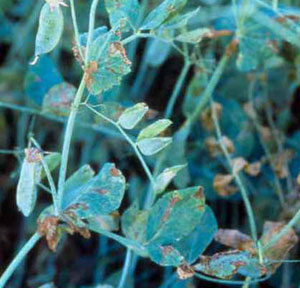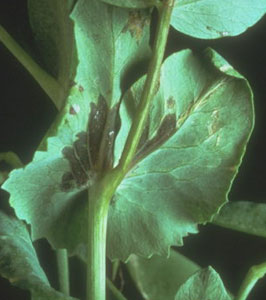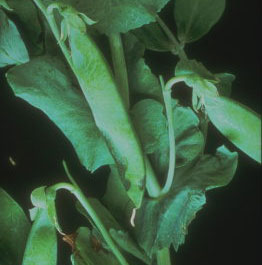
Bacterial disease such as pea blight can be tricky to diagnose since bacteria aren’t visible to the human eye; in fact they can only be seen under high magnification (x 1,000).
Pea blight is caused by Pseudomonas syringae pv. pisi and/or P. syringae pv. syringae. Laboratory tests will reveal the presence of bacteria, but as these tests can be costly, it’s not really a consideration for the home gardener.
Disease symptoms on plants can be confused with fungal diseases, environmental extremes, chemical toxicities and even senescence.
Take heart though, blight of peas can be more of a problem in large scale horticulture than in the home garden. But in the home garden it could affect all the peas in a small space and wipe the whole lot out. However, in the home garden it is easily controlled by keeping your soil healthy with organic matter and manures, and rotating crops.

Symptoms
Small, dark-green marks that look soaked with water appear on the leaflets (as shown here). These lesions enlarge and merge together (coalesce), but are limited in their expansion by the leaf’s veins.
The lesions on leaves turn yellowish and are later brown and distinctly papery. Lesions on pods (shown below) are sunken and turn an olive-brown. Lesions can also develop on stems near ground level, beginning as ‘water-soaked’ areas. When these lesions coalesce they cause the stem to shrivel and die.
Stem infection may spread upwards into the leaves and stipules.
Infected seedlings are killed very readily, but even advanced plants can be killed by the disease.
Heavily infected seed may be discoloured. However, there is no visible effect on seed with light infection.
Spread
Spread of the bacteria is by seed or survival in pea trash. Rain-splash and wind-borne water droplets can also spread the bacteria.
Excessive rainfall and strong winds are the most favourable environmental conditions. And plants damaged by frosts and heavy rain are most susceptible to attack.

Prevention
Blight is most severe in wet seasons, so be vigilant when conditions are most favourable to the disease.
Purchase clean seed and, of course, do not use seed from plants that have any disease symptoms.
Seed treatments are not effective for the control of bacterial blight.
Do not grow peas in the same place each year, or even adjacent to an area of pea stubble. In fact, peas should not be grown in the same place more than once in three years.
Early sown crops are more vulnerable than late sown crops. Never sow earlier than recommended for your district.
Control
Bacteria will survive on pea stubble, so if infection is suspected, bury the pea trash 10cm below the soil surface, which reduces the survival time of the bacteria significantly.
Better still, remove all infected plant parts, bag and put in the rubbish bin.
Peas should then only be grown on a rotation of one in four years.
There are copper-based compounds available for the control of this disease in field peas but their effectiveness is ‘limited and inconclusive’ (DPI Victoria). Fungicides are for fungal diseases, they do not work on bacteria.
Information sources:
Kerruish, R.M., & Unger, P.W., 2003, Plant Protection 1, 3rd Edition, published by RootRot Press ACT.
Richardson, H. & Hollaway, G., 2007, ‘Bacterial Blight of Field Peas‘, Agricultural Notes, July, AG0148, State of Victoria, Department of Primary Industries.
Related Articles:
Pest Alert: Polyphagous Shot-Hole Borer (PSHB)
The Polyphagous shot-hole borer (known as PSHB; Euwallacea fornicates) is a pest first detected in Australia 2021 in metropolitan Perth. Native to…
Tomato Brown Rugose Fruit Virus (ToBRFV)
Tomato Brown Rugose Fruit Virus (ToBRFV) is a plant virus that causes severe crop losses (up to 75%) in tomatoes, but also in peppers (capsicums and…


